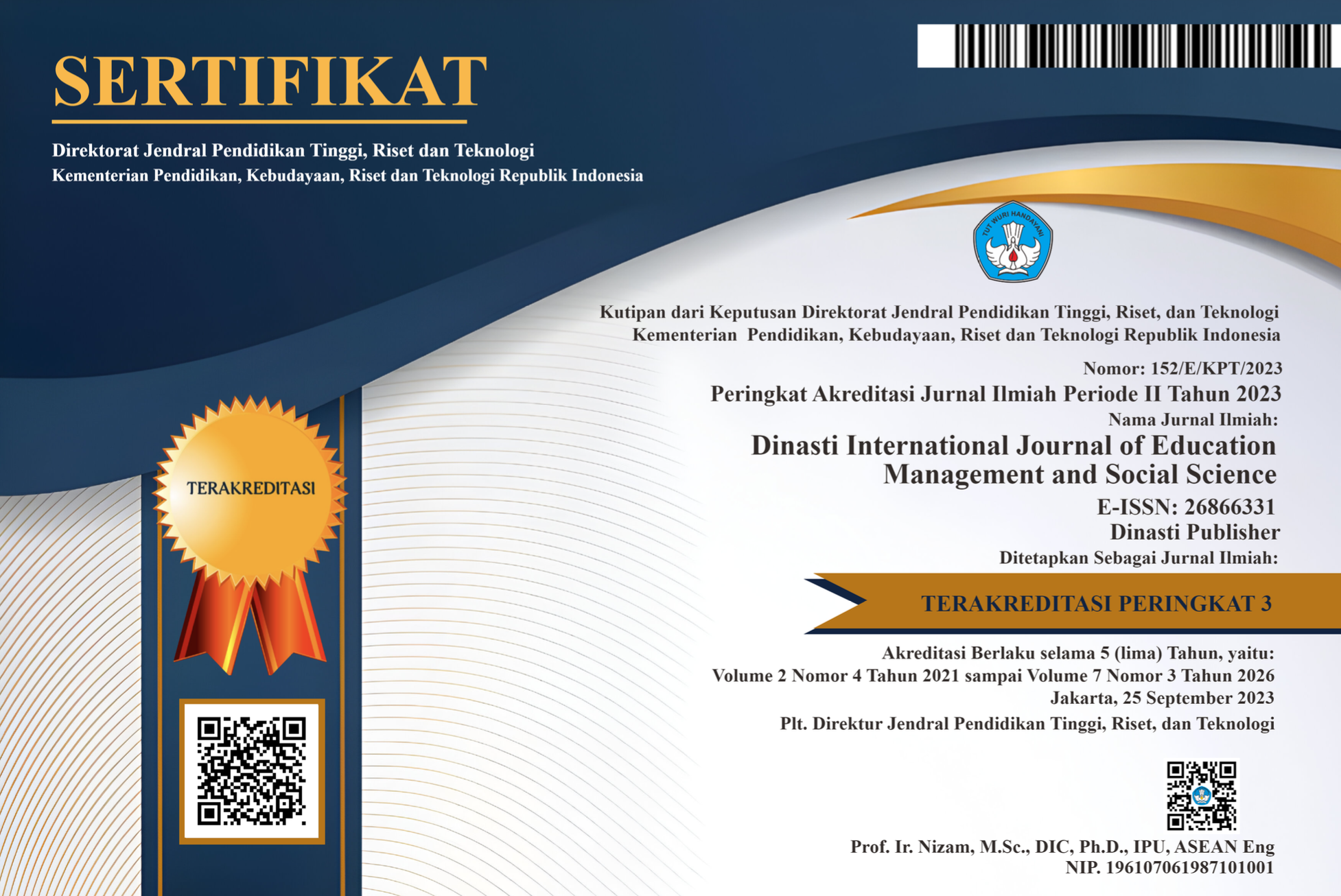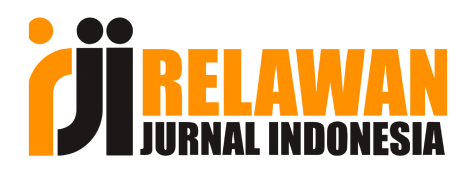Analysis of the Influence of Liquidity, Solvency, and Interest Rates on Company’s Return on Assets
DOI:
https://doi.org/10.38035/dijemss.v6i5.4647Keywords:
Liquidity, Solvency, Interest Rate, Return on Assets, Conventional Banks, Infobank15, SURAbstract
This study aims to analyze the influence of liquidity, solvency, and interest rates on Return on Assets (ROA) in conventional banks listed in the Infobank15 index during the period 2019–2023. In the context of economic dynamics caused by the COVID-19 pandemic and changes in monetary policy, this research adopts a quantitative approach using panel data regression and the Seemingly Unrelated Regression (SUR) estimation method. The results show that, partially, the Capital Adequacy Ratio (CAR) and interest rates have a positive and significant effect on ROA, while the Current Ratio (CR) has no significant effect. Simultaneously, the three independent variables are proven to significantly influence ROA. These findings provide important implications for bank management, regulators, and investors in formulating strategies to enhance profitability and stability in Indonesia's banking sector.
References
Adeyemi, B. (2011). Bank failure in Nigeria: a consequence of capital inadequacy, lack of transparency and non-performing loans? Banks & Bank Systems, 6, Iss. 1, 99–109.
Ahmad, M., Kahwaji, A., Durrah, O., & Allil, K. (2016). The impact of strategic flexibility on the performance of private banks during the crisis in Syria. International Journal of Economic Research, 13(5), 2087–2095.
Ali, A. (2021). Liquidity variations and variability cohesiveness with revenue and profitability: A case of saudi energy sector companies. Accounting, 7(4), 763–770. https://doi.org/10.5267/j.ac.2021.2.008
Amanda, A. L., Efrianti, D., & Marpaung, B. `Sahala. (2019). Analisis Pengaruh Kandungan Informasi Komponen Laba Dan Rugi Terhadap Koefisien Respon Laba (Erc) Studi Empiris Pada Perusahaan Manufaktur Sektor Industri Dasar Dan Kimia Yang Terdaftar Di Bursa Efek Indonesia (Bei). Jurnal Ilmiah Manajemen Kesatuan, 7(1), 188–200. https://doi.org/10.37641/jimkes.v7i1.212
Ansori, M. F., Al Jasir, H., Sihombing, A. H., Putra, S. M., Nurfaizah, D. A., & Nurulita, E. (2024). Assessing the impact of deposit benchmark interest rate on banking loan dynamics. Computer Research and Modeling, 16(4), 1023–1032. https://doi.org/10.20537/2076-7633-2024-16-4-1023-1032
Aprilia, A., & Soebroto, N. W. (2020). Analisis Pengaruh Rasio Likuiditas, Efisiensi Operasi, Dan Rasio Solvabilitas Terhadap Kinerja Keuangan Pada PT Bank Maybank Indonesia Tbk Periode 2010-2018. Keunis, 8(2), 167-186.
Baltagi, B. H. (2005). Econometrics Analysis of Panel Data. In John Wiley & Sons Ltd (Vol. 3). https://doi.org/10.3109/00498257509056115
Carolina, V., Marpaung, E. I., & Pratama, D. (2017). Analisis rasio keuangan untuk memprediksi kondisi financial distress (Studi empiris pada perusahaan manufaktur yang terdaftar di Bursa Efek Indonesia periode 2014-2015). Jurnal Akuntansi, 9(2).
Ceylan, I. E. (2021). The impact of firm-specific and macroeconomic factors on financial distress risk: A case study from Turkey. Universal Journal of Accounting and Finance, 9(3), 506–517.
Chen, I. J., Tsai, H., Chen, Y. S., Lin, W. C., & Li, T. Y. (2024). Bank performance and liquidity management. Review of Quantitative Finance and Accounting, 1-38.
Chen, X., Liu, G., Liu, Y., & Zhang, Y. (2022). Banks’ liability structure and risk taking: Evidence from a quasi-natural experiment in China. Finance Research Letters, 49. https://doi.org/10.1016/j.frl.2022.103100
Chohan, U. (2021). Public value and the digital economy. Routledge.
Choudhury, M. M. (2024). Signaling Theory. Journal of Accounting-Business Dan Management, 31(2), 98.
Cronjé, T., & de Beer, J. (2010). Combining efficiency with ROA: Indicator of future relative performance - South African banking groups. Corporate Ownership and Control, 7(4 C), 287–296. https://doi.org/10.22495/cocv7i4c2p4
Dendawijaya, L. (2009). Manajemen Perbankan. Jakarta: Ghalia Indonesia.
Diyanto, V. (2020). The effect of liquidity, leverage and profitability on financial distress. Indonesian Journal of Economics, Social, and Humanities, 2(2), 127–133.
Ender, M., & Neuhofer, C. (2021). Implications Of Low Interest Rates On Bank Profitability And Risk-Taking. Journal of Financial Management, Markets and Institutions, 9(1). https://doi.org/10.1142/S2282717X21500031
Fikri, P. M., & Manda, G. S. (2021). Pengaruh Risiko Suku Bunga BI, Risiko Inflasi, dan Risiko Nilai Tukar terhadap Profitabilitas pada Bank BNI Syariah periode 2012-2019. Akuntansi Dewantara, 5(2), 122-135.
Hassan, S. U., Sabo, B., & Aliyu, I. A. (2023). Moderating effect of bank size on the relationship between interest rate, liquidity, and profitability of commercial banks in Nigeria. Gusau Journal of Accounting and Finance, 4(1), 96–120.
Herlianto, A., Sofilda, E., Hamzah, M. Z., & Ginting, A. M. (2020). The effect of market intervention policy through capping rate on credit growth | Keberkesanan Dasar Intervensi Pasar Melalui Kadar Penetapan ke atas Pertumbuhan Kredit. Jurnal Ekonomi Malaysia, 54(3). https://doi.org/10.17576/JEM-2020-5403-02
Horngren, C.T., & Harrison, W. T. (2007). Akuntansi Buku II. Edisi 7. Jakarta: Erlangga
Hutagalung, Esther Novelina, Djumahir, Kusuma Ratnawati. 2013. “Analisa Rasio Keuangan Terhadap Kinerja Bank Umum di Indonesia”. Jurnal Aplikasi Manajemen. Volume 11, Nomor 1. ISSN 1693-5241.
Indonesia, B. (2024). Memahami Suku Bunga Acuan BI: Kunci Ambil Keputusan Keuangan yang Tepat. Bank Indonesia.
Iyer, R., Puri, M., & Ryan, N. (2016). A Tale of Two Runs: Depositor Responses to Bank Solvency Risk. Journal of Finance, 71(6), 2687–2726. https://doi.org/10.1111/jofi.12424
Jensen, M. C., & Meckling, W. H. (2019). Theory of the firm: Managerial behavior, agency costs and ownership structure. In Corporate governance (pp. 77–132). Gower.
Karamoy, H., & Tulung, J. E. (2020). The impact of banking risk on regional development banks in Indonesia. Banks and Bank Systems, 15(2), 130–137. https://doi.org/10.21511/bbs.15(2).2020.12
Kasmir. 2010. Analisis Laporan Keuangan. Jakarta: Rajawali Pers.
Kipkemoi, M. A. (2019). Effect of inventory management practices on liquidity of public technical training institutions in Rift valley region, Kenya. American Journal of Humanities and Social Sciences Research, 81–87.
Lestari, S., & Sudaryono, E. A. (2008). Pengaruh stock split: Analisis likuiditas saham pada perusahaan go public di Bursa Efek Indonesia dengan memperhatikan pertumbuhan dan ukuran perusahaan. Jurnal Bisnis Dan Akuntansi, 10(3), 139–148.
Magdalena, R., Lucian, B., & Maria, D. S. (2021). The Profitability of the Central and Eastern European Banking Systems in Correlation with the Macroeconomic Environment. In Contributions to Economics. https://doi.org/10.1007/978-3-030-82778-6_14
Mandeij, D., Rumate, V. A., & Rompas, W. F. I. (2019). The influence of exchange rate, international interest rate and inflation rate on lending and deposit rate of indonesia banking sector through reference policy rate as intervening variable. International Journal of Engineering and Advanced Technology, 8(5C), 204–213. https://doi.org/10.35940/ijeat.E1030.0585C19
Mohanty, S., & Mahakud, J. (2019). Dynamic Adjustment Towards Target Capital Adequacy Ratio: Evidence from Indian Commercial Banks. Global Business Review, 20(3), 757–768. https://doi.org/10.1177/0972150919837082
Nawawi, A., Disman, Nugraha, & Waspada, I. (2024). THE PRICE TO BOOK VALUE STILL INFLUENCED BY THE MAIN FACTORS ON SDG’S? Journal of Lifestyle and SDG’S Review, 4(1). https://doi.org/10.47172/2965-730X.SDGsReview.v4.n00.pe01629
Nevile, J. W. (2019). The rate of interest. In Post-Keynesian Essays from down under Volume IV: Essays on Theory: Theory and Policy in an Historical Context. https://doi.org/10.1057/978-1-137-47529-9_31
Nguyen, H., Do, D. T., Nguyen, T. H. T., Nguyen, T. T. T., Tran, M. D., Nguyen, T. T., Pham, V. H., & Nguyen, T. T. (2022). The Impact Of Internal Financial Determinants On The Financial Performance Of Listed Mineral Firms On The Vietnam Stock Exchange. Corporate Governance and Organizational Behavior Review, 6(2 Special), 287–299. https://doi.org/10.22495/cgobrv6i2sip13
Noco?, A., & Pyka, I. (2019). Sectoral analysis of the effectiveness of bank risk capital in the visegrad group countries. Journal of Business Economics and Management, 20(3), 424–445. https://doi.org/10.3846/jbem.2019.9606
Nugraha, N. N. A., & Manda, G. S. (2021). Pengaruh Inflasi, BI 7 Days Reverse Repo Rate, dan Nilai Tukar Terhadap Profitabilitas Perbankan. Jurnal Riset Manajemen Sains Indonesia (JRMSI), 12(2), 200-216.
O’Leary, D. E. (2020). A Signal Theory Model for Continuous Monitoring and Intelligence Systems. Journal of Emerging Technologies in Accounting, 17(2), 201–213.
Pakhucha, E., Sievidova, I., Siadrysta, I., Mohilevsky, L., Oliynik, T., & Bogdanovych, O. (2021). Financial risks in the conditions of unstable market economy. European Journal of Sustainable Development, 10(1), 432–449. https://doi.org/10.14207/ejsd.2021.v10n1p432
Pepper, A., & Gore, J. (2015). Behavioral agency theory: New foundations for theorizing about executive compensation. Journal of Management, 41(4), 1045–1068.
Pivetti, M. (2024). A Note on the Real Effects of Interest Rate Policy and Its Impact on Inflation. Review of Political Economy, 36(2), 600–609. https://doi.org/10.1080/09538259.2023.2238997
Poerba, R. M., Triana, L., Yuliah, Y., & Febrian, W. D. (2024). Pengaruh Likuiditas Terhadap Profitabilitas pada PT. Mulia Industrindo, Tbk Periode 2011-2022. Jurnal Neraca Peradaban, 4(1), 26-31.
Prasetyo, Dwi Agung, Darmayanti, Ni Putu Ayu. 2015. “Pengaruh Risiko Kredit, Likuiditas, Kecukupan Modal, dan Efisiensi Operasional Terhadap Profitabilitas Pada BT BPD Bali”. E-Jurnal Manajemen Unud. Volume 4, Nomor 9. ISSN 2302-8912.
Pražák, T. (2022). Application of Methods of Comprehensive Evaluation of a Company in the Conditions of the Visegrad Group’s Countries. Springer Proceedings in Business and Economics, 451–464. https://doi.org/10.1007/978-3-030-98179-2_31
Puspitasari, E., Sudiyatno, B., Aini, N., & Anindiansyah, G. (2021). The relationship between net interest margin and return on asset: empirical study of conventional banking in Indonesia. Academic Journal of Interdisciplinary Studies, 10(3), 362–374. https://doi.org/10.36941/AJIS-2021-0090
Puspitasari, N. D. (2023). Pengaruh kebijakan moneter bank sentral terhadap kinerja keuangan bank umum. Jurnal Cendekia Keuangan, 2(1), 42-54.
Putera, A. P. (2020). Prinsip Kepercayaan Sebagai Fondasi Utama Kegiatan Perbankan. Jurnal Hukum Bisnis Bonum Commune, 3(1), 457294.
Reschiwati, R., Syahdina, A., & Handayani, S. (2020). Effect of liquidity, profitability, and size of companies on firm value. Utopia y Praxis Latinoamericana, 25(6), 325–332.
Rodrigues, R. R., & Guest, D. (2024). Signalling theory (pp. 254–260). Edward Elgar Publishing.
Shi, W., Connelly, B. L., & Hoskisson, R. E. (2017). External corporate governance and financial fraud: Cognitive evaluation theory insights on agency theory prescriptions. Strategic Management Journal, 38(6), 1268–1286.
Siekelová, A., Weissová, I., & Kollár, B. (2015). Default prediction of chosen car manufacturing company. Transport Means - Proceedings of the International Conference, 2015-Janua, 509–512.
Siregar, S., & Nurlaila, N. (2023). BANK EFFICIENCY BEFORE, DURING, AND AFTER COVID-19: A LESSON LEARNED FROM INDONESIA. International Journal of Economics and Finance Studies, 15(4), 43–63. https://doi.org/10.34109/ijefs.202315403
Spence, M. (1973). Job Market Signaling. The Quarterly Journal of Economics, 87(3), 355–374. Studies, 10(3), 362–374. https://doi.org/10.36941/AJIS-2021-0090
Sugiyono. (2019). Metode Penelitian Kuantitatif, Kualitatif dan R&D. Alfabeta.
Sunaryo, D., Nafiuddin, Gentari, R. E., & Adiyanto, Y. (2022). Using Current Ratio Indicator and Total Asset Turnover Approach in Solving Return on Assets Problems with Debt-to-Equity Ratio Moderated. Quality - Access to Success, 23(189), 199–209. https://doi.org/10.47750/QAS/23.189.23
Tangngisalu, J., Hasanuddin, R., Hala, Y., Nurlina, N., & Syahrul, S. (2020). Effect of CAR and NPL on ROA: Empirical study in Indonesia Banks. Journal of Asian Finance, Economics and Business, 7(6), 9–18. https://doi.org/10.13106/JAFEB.2020.VOL7.NO6.009
Tzenova, Z. (2023). Analysis of the financial condition of a company. AIP Conference Proceedings, 2939(1). https://doi.org/10.1063/5.0184668
Wahyudi, S., Sari, S. P., Hersugondo, H., & Udin, U. (2019). Capital adequacy ratio, profit-sharing and return on asset: Case study of Indonesian sharia banks. WSEAS Transactions on Business and Economics, 16, 138–144.
Wójcicka, A. (2018). Credit-Risk Decision Process Using Neural Networks in Industrial Sectors. Springer Proceedings in Business and Economics, 71–81. https://doi.org/10.1007/978-3-319-72862-9_6
Wooldridge, J. M. (2010). Econometric Analysis of Cross Section and Panel Data (Second Edi, Issue 2). The MIT Press, Cambridge, Massachusetts London, England.
Downloads
Published
How to Cite
Issue
Section
License
Copyright (c) 2025 Mastuti Sabiantoro, Mentiana Sibarani

This work is licensed under a Creative Commons Attribution 4.0 International License.
Authors who publish their manuscripts in this journal agree to the following conditions:
- The copyright on each article belongs to the author(s).
- The author acknowledges that the Dinasti International Journal of Education Management and Social Science (DIJEMSS) has the right to be the first to publish with a Creative Commons Attribution 4.0 International license (Attribution 4.0 International (CC BY 4.0).
- Authors can submit articles separately, arrange for the non-exclusive distribution of manuscripts that have been published in this journal into other versions (e.g., sent to the author's institutional repository, publication into books, etc.), by acknowledging that the manuscript has been published for the first time in the Dinasti International Journal of Education Management and Social Science (DIJEMSS).















































